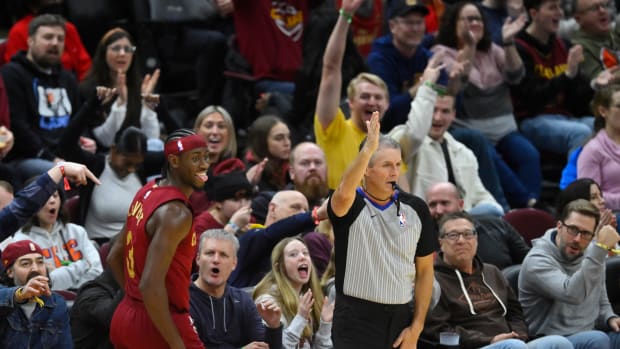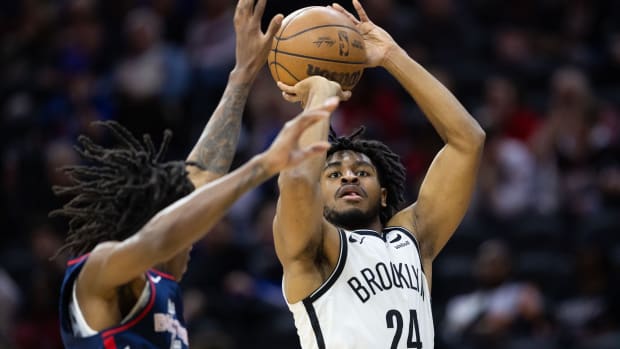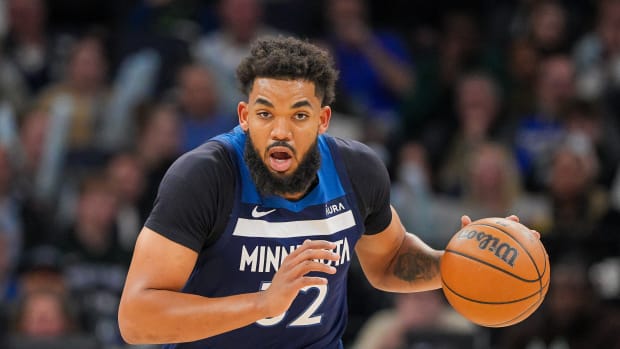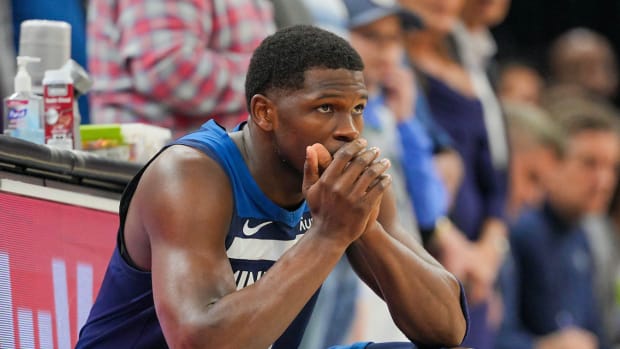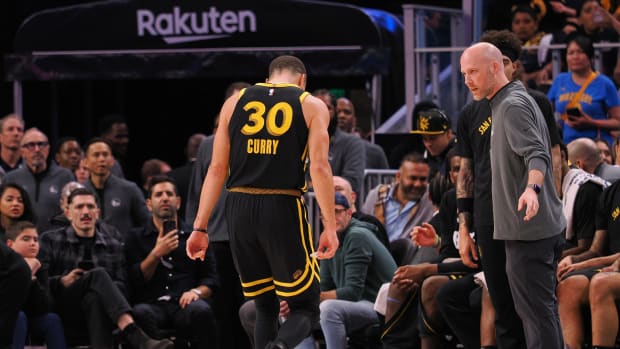Why staying with the Thunder would pay off for Kevin Durant
Your teams. Your favorite writers. Wherever you want them. Personalize SI with our new App. Install on iOS or Android.
No matter where Kevin Durant plays next season, the free agent will be paid extremely well: Durant will earn approximately $26 million as part of a maximum NBA contract. If Durant, the league’s Most Valuable Player two years ago, remains with the Oklahoma City Thunder, he would maximize his wages. Under the so-called “Larry Bird exception,” which allows teams to sign their own free agents for more money than other teams, Durant’s contract with the Thunder would increase in value by 7.5% each year. If Durant instead signs with another team, his contract would annually increase in value by only 4.5%. Regardless of the team he plays for, Durant will also earn substantial income from the 10-year, $300 million contract he signed with Nike in 2014.
Lurking in the background of these numbers is the powerful role of state income taxes. Durant’s after-tax, take-home pay will vary based on to what extent his earnings are subject to state income taxes. If Durant seeks to maximize his take-home pay, state tax differences could position the Miami Heat and San Antonio Spurs as the leading franchises to secure his services.
Durant has reportedly scheduled meetings with six teams: the Heat, Spurs, Oklahoma City Thunder, Boston Celtics, Los Angeles Clippers and Golden State Warriors. These teams play in states with very different tax laws. The Heat and Spurs play in two states—Florida and Texas, respectively—that do not impose a state income tax. The Celtics, in contrast, play in Massachusetts, which imposes a 5.1% state income tax, while the Thunder play in Oklahoma, where the highest earning citizens are taxed at 5.25%. The Clippers and Warriors play in the most heavily taxed state, California, where Durant’s salary would be subject to a 13.3% tax rate.
•Anything is possible for Kevin Durant | KD’s free agency, explained
The extent to which Durant would be subject to state income taxes would depend on which state Durant resides. With the massive increase in NBA television revenue and corresponding increase in the salary cap, the disparity in state income taxes is larger than ever.
How Durant’s take-home pay is impacted by state taxes
To see the impact of state income tax differences on Durant’s take-home pay, we break down how much money Durant would actually “take home” by signing max deals with each of the six teams. Note that the NBA’s collective bargaining agreement permits Durant to sign a four-year deal with five of those franchises and a five-year deal with his current team, the Thunder.
We make six key assumptions. First, and most meaningfully, we assume that Durant will sign the longest contract possible. Durant could instead sign a shorter-term contract, such as by resigning with the Thunder for one-year with a player option. He could then sign a long-term max contract in 2017, when a max contract would be expected to be of higher value. Under the NBA’s current collective bargaining agreement with the NBPA, maximum salaries for players with Durant’s nine years of service are based on the higher of 30% of the salary cap or 105% of his salary in the last year of his contract. After the 2016–17 season, however, Durant would have accrued 10 years of service and would be able to sign a more lucrative max contract—the value would based on the higher of 35% of the salary cap or 105% of his salary in 2016–17.
• SI’s top 50 free agents available | Finding perfect fits for 10 free agents
There is some risk for Durant in waiting till July 2017 to sign a max contract. For one, the NBA and NBPA have until Dec. 15 to provide notice of intent to opt out of the existing CBA. The two sides would then attempt to negotiate a new CBA. It is unclear how a new CBA might impact the calculus of max contracts. In addition, Durant could suffer a significant injury during the 2016–17 season and no longer be positioned to earn more as a free agent. For purposes of our chart, we assume that Durant will sign a long-term deal now and enjoy the security of knowing the money is fully guaranteed.
As a second assumption, we assume Durant will reside in the state where his team plays. Players normally reside in the states where they play, but Durant would not be obligated to do so. Third, we deduct the standard 4% agent commission from his NBA contract. Fourth, we assume Durant earns $30 million a year from his 10-year, $300 million endorsement deal with Nike. Fifth, for purposes of this illustration, we decline to guess what his agent commission would be on his Nike deal. We are only using earnings from his NBA contract and Nike deal.
Without further adieu, our data:
These charts reveal that Durant, over the next four years, could earn $18.3 million more playing for the Heat or Spurs than he would playing for the Warriors or Clippers. This is true even though his wages would be the same on all four teams. During that same four-year deal, Durant could also earn $13.9 million more playing for the Thunder than he would playing for either of the Californian teams, plus be certain to receive an additional $33.5 million from the Thunder in wages during the 2020–21 season.
The disparity in take-home pay for max players is nothing new in the NBA. We highlighted this issue when Carmelo Anthony and LeBron James were set to become free agents in 2014.
Differences in state income taxes are of course not the only distinguishing characteristics of these six teams. Each has certain qualities that likely attract Durant. The Thunder, for instance, have been Durant’s team since the start of his NBA career and he could sign with them for a fifth year. The Celtics have a very promising future and could sign Durant and another NBA star—perhaps Al Horford, whom Durant would reportedly like to play with—to max contracts. The Clippers and Heat are playoff teams in locales that may be of particular interest to Durant. The Spurs and Warriors are two of the best teams in the NBA. There are plenty of other distinctions, including cost of living (California, for example, is the fifth most expensive to live), proximity to family and culture. State income tax differences, in other words, are not the only issue. But they matter.
Kevin Durant leads SI’s top NBA free agents available
Top NBA Free Agents of 2016
1. Kevin Durant
2. LeBron James (player option)
3. Andre Drummond (restricted)
4. Al Horford
5. Mike Conley
6. Hassan Whiteside
7. Dwight Howard
8. Bradley Beal (restricted)
9. Nicolas Batum
10. Dwyane Wade
11. DeMar DeRozan
12. Tim Duncan (player option)
13. Dirk Nowitzki
14. Chandler Parsons
15. Pau Gasol
16. Bismack Biyombo
17. Ian Mahinmi
18. Festus Ezeli (restricted)
19. Ryan Anderson
20. Marvin Williams
21. Al Jefferson
22. Harrison Barnes (restricted)
23. Kent Bazemore
24. Evan Fournier (restricted)
25. J.R. Smith
26. Courtney Lee
27. Jordan Clarkson (restricted)
28. Luol Deng
29. Evan Turner
30. Jeremy Lin
NBA and NBPA should explore equivalency clauses and cap adjustments
As we recently argued on SI.com in regard to the Los Angeles Rams, significant financial disparities caused by varying states taxes and costs of living among franchises undermine the “leveling the playing field” rationale for salary caps and maximum salaries. After all, if the Spurs and Heat, along with other teams that play in states without income taxes, can effectively offer Durant and other max players millions of dollars more than other teams, then the bidding process for players is skewed in favor of similarly-situated franchises.
One possible remedy to this imbalance would be for the NBA and NBPA to collectively bargain the inclusion of what we call “equivalency clauses” in max contracts. These clauses would adjust the monetary value of max contracts to account for state income tax and cost of living differences. There would also need to be corresponding adjustments to the league’s salary cap figure, so that teams in higher taxed states would be assigned greater cap space. These adjustments could become part of a tax-adjusted salary cap. With Durant, for example, he might earn a slightly higher salary in a max contract by signing with the Clippers or Warriors than with the Massachusetts-based Celtics, where the state income tax is lower than in California.
To be sure, the NBA and NBPA negotiating appropriate formulas for equivalency clauses and salary cap adjustments would be challenging and contentious. Such formulas would also require periodic updates to reflect any tax law changes. Yet in the absence of equivalency clauses, certain teams will have a built-in advantage to sign max players: They can offer players the opportunity to take home much more money than other teams. We’ll soon find out whether Durant is influenced by that dynamic.
Michael McCann is a legal analyst and writer for Sports Illustrated. He is also a Massachusetts attorney and the founding director of the Sports and Entertainment Law Institute at the University of New Hampshire School of Law. McCann also created and teaches the Deflategate undergraduate course at UNH. He serves on the Board of Advisors to the Harvard Law School Systemic Justice Project and is the distinguished visiting Hall of Fame Professor of Law at Mississippi College School of Law. He is also on the faculty of the Oregon Law Summer Sports Institute.
Robert Raiola is the Director of the Sports and Entertainment Group at the accounting & advisory Firm PKF O’Connor Davies. He has more than 20 years of experience in the public and private sector providing business management services, tax planning and business consulting to high net worth individuals and their families in the sports and entertainment industries.

































































